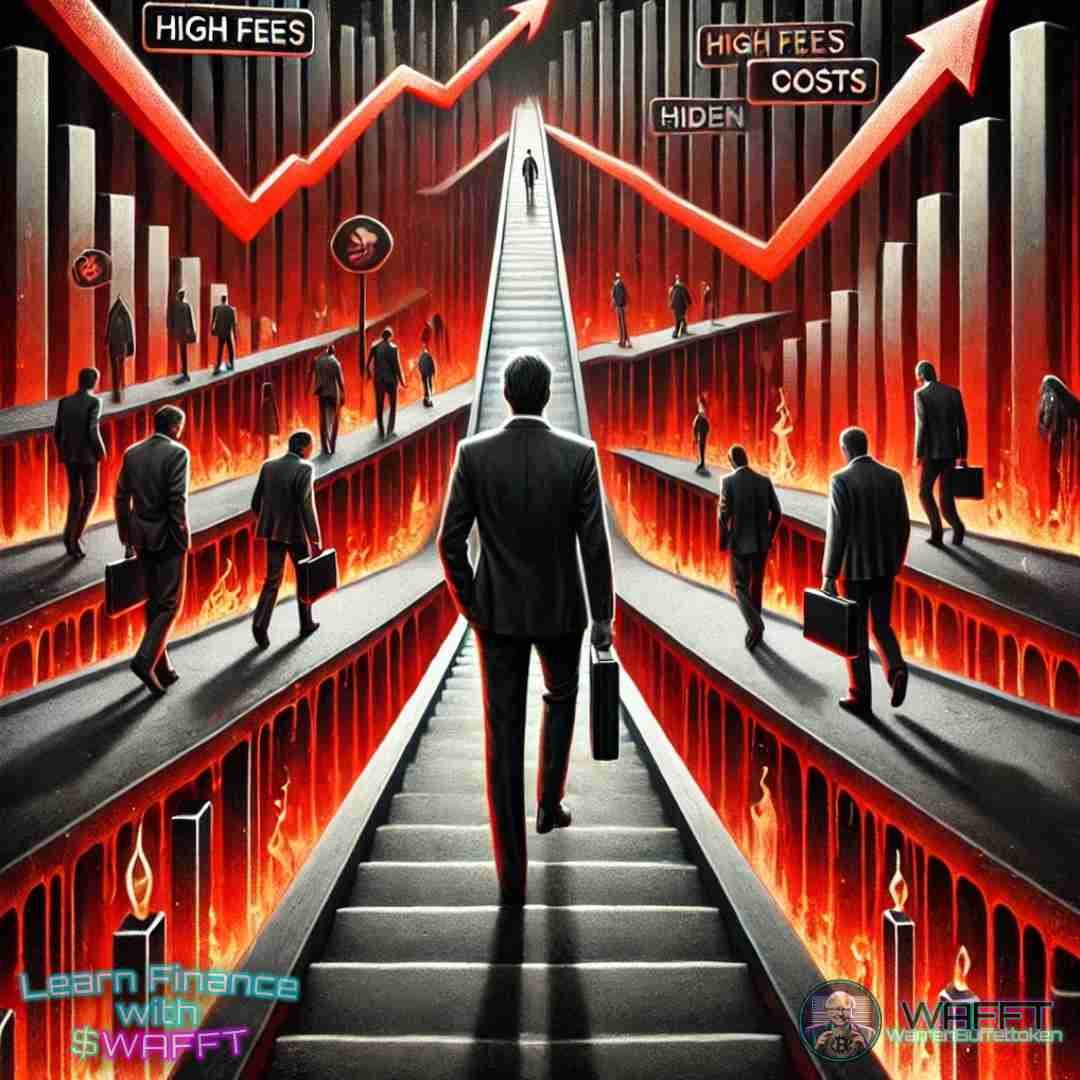Mutual Funds:
Everything You Need to Know to Invest in Style 💰✨
Hello, future investors! 👋 If you’ve ever wondered what a mutual fund is and why everyone is talking about them, you’ve come to the right place! In this article, we’re going to break down this financial concept in a simple and fun way.
So, get ready to dive into the world of investing! 🚀

How Does a Mutual Fund Work? 🛠️
Fundraising 💰
Mutual funds start with investors like you and me buying shares or units of the fund. Imagine a big pot where we all put our money:
- Small and large investors can participate.
- The money is pooled into a single fund, creating a collective purchasing power.
- Each investor receives a number of units proportional to their investment.
Professional Management 🧠
This is where the team of experts comes into play:
- A fund manager, backed by financial analysts, makes the investment decisions.
- These professionals study the market, analyze trends, and select assets.
- Their job is to maximize returns while managing risks.
Diversification 🌈
Diversification is like not putting all your eggs in one basket:
- The fund invests in a variety of assets: stocks, bonds, cash, etc.
- They can include different sectors, geographic regions, and types of companies.
- This strategy helps mitigate risks: if one sector falls, others can compensate.
Performance 📈
This is where you see the fruits of your investment:
- The value of your shares fluctuates daily based on the performance of the fund’s assets.
- You can make money in two ways:
1. Capital appreciation: when the value of the shares increases.
2. Dividends or interest: distributed by the fund’s assets.

Types of Mutual Funds: A Financial Menu 🍽️
If you’re looking to understand the universe of mutual funds, you’ve come to the right place. You won’t find vague explanations or incomplete lists here; at WAFFT we give you all the valuable information that you won’t find anywhere else.
From fixed–income funds to equity funds, including mixed and sector funds, we break down each one for you in a clear, direct and to the point style, in true WAFFT style.
Get ready to learn how they work, how they differ and which one could be ideal for your financial goals. Let’s get to it! 🚀
In the world of investing, mutual funds are like a delicious fruit salad! 🍉🍌🍓 Imagine all the ingredients being different types of financial assets, mixed together by an expert chef (or fund manager) who knows exactly how to combine each one for the best flavor.
These funds allow investors, from the most novice to the most experienced, to diversify their money without having to be financial geniuses. Whether you’re looking for stability, growth, or a little bit of both, there’s a perfect mutual fund for you.
So get ready to explore the different types of mutual funds and find out which one best suits your financial palate. Let’s dive into this buffet of options! 🍽️💰
Fixed Income Funds 🏦
Fixed income refers to investment instruments that offer a predetermined return over a specific time frame. These funds:
- Invest primarily in government bonds, corporate bonds, and other debt instruments.
- Offer more predictable and stable returns.
- Are considered lower risk compared to other types of funds.
- Ideal for conservative investors or those seeking regular income.
📌Detailed example:
Imagine a fund called «Stability Plus« that invests in a mix of 10–year Treasury bonds and corporate bonds from AAA–rated companies. The fund could have 60% of its portfolio in government bonds and 40% in corporate bonds. If Treasury bonds offer a return of 2% per year and corporate bonds 3.5%, the fund could provide an average return of 2.6% per year, before expenses. This type of fund would be attractive to a retired investor seeking a stable income and willing to accept a moderate return in exchange for lower risk.
Equity Funds 📊
Equity refers to investments whose performance is not guaranteed and fluctuates based on the performance of the company or the market. These funds:
- Focus primarily on company stocks.
- Offer greater long-term growth potential.
- Involve greater risk and volatility.
- Are suitable for investors with a higher risk tolerance and longer investment horizon.
📌Detailed example:
Consider a fund called «Global Technology Growth« that invests in stocks of fast-growing technology companies around the world. This fund might hold positions in technology giants like Apple, Microsoft, and Amazon, as well as in artificial intelligence and biotechnology startups. In a year of strong economic growth and technological advancements, this fund might generate a return of 25% or more. However, in a year of a recession or technological crisis, it could experience significant losses. This type of fund would be suitable for a young investor with an investment horizon of 20 years or more, who can tolerate short-term volatility in search of higher long-term returns.
Mixed Funds 🔀
These funds seek the best of both worlds, combining fixed–income and equity characteristics:
- They invest in both bonds and stocks.
- They seek a balance between stability and growth potential.
- The percentage of each type of asset can vary depending on the fund’s strategy.
- They are suitable for investors seeking diversification in a single product.
📌Detailed example:
A mixed fund called «Global Balance« might hold 60% in corporate bonds and 40% in stocks from companies in different sectors and regions. The fixed-income portion might include corporate bonds from companies like Coca–Cola or Johnson & Johnson, offering stability and regular income. The equity portion might invest in growth stocks like Tesla or Netflix, as well as value stocks like Berkshire Hathaway. In a typical year, if bonds yield 3% and stocks yield 8%, the fund might offer a total return of around 5%. This type of fund would be ideal for a middle-aged investor who seeks moderate growth but also values capital preservation.
Money Market Funds 💵
These funds focus on very short–term investments:
- They invest in short–term debt instruments, such as treasury bills or certificates of deposit.
- They offer high liquidity and low risk.
- They are ideal for cash reserves or short-term investments.
- They typically have low but stable returns.
📌Detailed example:
A money market fund called «Safe Liquidity» might invest in a combination of 3–month treasury bills, 30–day bank certificates of deposit, and high-quality corporate notes with maturities of 60 days or less. This fund might offer an annual yield of 1.5% in a low interest rate environment. Although the yield is modest, the fund provides high safety and liquidity. It would be ideal for an investor who needs to temporarily park money, perhaps while waiting for a long-term investment opportunity or for an emergency fund.
Index Funds 📈
These funds seek to replicate the performance of a specific market index:
- They passively track an index such as the S&P 500 or the Nasdaq Composite.
- They offer automatic diversification within the index they replicate.
- They usually have lower fees than actively managed funds.
- They are ideal for investors who believe in long-term market efficiency.
📌Detailed example:
Consider a fund called «S&P 500 Tracker« that exactly replicates the composition of the S&P 500. If Apple represents 7% of the index, this fund will invest 7% of its assets in Apple stock. If the S&P 500 rises by 15% in a year, this fund will seek to obtain a similar return, less management fees that could be 0.03% per year. This type of fund would be ideal for an investor who wants exposure to the US market in a diversified manner and with low costs, without trying to beat the market.

Sector Funds 🏭
These funds specialize in specific economic sectors:
- They invest in companies in a particular sector such as technology, healthcare, or energy.
- They offer concentrated exposure to specific industries.
- They can be more volatile but also offer greater growth potential.
- They are suitable for investors who have a positive view on specific sectors.
📌Detailed example:
A fund called «Global Green Energy« could invest exclusively in renewable energy companies. This fund could include stocks of solar panel manufacturers such as First Solar, wind energy companies such as Vestas Wind Systems, and energy storage companies such as Tesla. In a year of strong push for clean energy policies, this fund could generate returns of over 20%. However, it could also suffer significant losses if government policies change unfavorably. This fund would be suitable for an investor who strongly believes in the future of renewable energy and is willing to take on the volatility associated with a specific sector.
High Yield Bond Funds 💎
These funds seek higher returns in the fixed-income world:
- They invest in bonds from companies with lower credit ratings.
- They offer potentially higher returns than traditional bonds.
- They carry a higher risk of default.
- They are suitable for investors who seek higher income and can tolerate more risk.
📌Detailed example:
A fund called «Yield Plus» might invest in corporate bonds with ratings below investment grade, often called «junk bonds.» This fund might include bonds from growth companies or in cyclical sectors that offer interest rates of 6–8% per year, compared to 2–3% for investment-grade bonds. However, these companies have a higher risk of default. In a strong economic year, the fund might generate total returns of 10% or more, but in a downturn, it could face significant losses if some companies default. This type of fund would be suitable for an investor who seeks high income and can tolerate volatility and the risk of capital loss.
Emerging Markets Funds 🌍
These funds focus on developing economies:
- They invest in stocks or bonds from countries considered emerging.
- They offer high growth potential but with greater volatility.
- They may face additional political and economic risks.
- They are suitable for investors who seek global diversification and have a high tolerance for risk.
📌Detailed example:
A fund called «BRIC Opportunities» could invest in a mix of stocks from Brazilian, Russian, Indian, and Chinese companies. It could include Chinese technology giants like Alibaba,Brazilian commodity producers like Vale, Russian energy companies like Gazprom, and Indian software companies like Infosys.
This fund could offer very high potential returns, perhaps 15–20% per year in good years, taking advantage of the rapid economic growth in these countries. However, you could also suffer large losses due to factors such as political instability, currency fluctuations, or regional economic crises. It would be suitable for an investor with a long-term horizon who seeks exposure to fast-growing economies and can tolerate high volatility.
Remember, each type of mutual fund has its own risk and return characteristics. Choosing the right fund will depend on your financial goals, investment horizon, and risk tolerance.
It is always advisable to do your own research or consult with a financial advisor before investing! 💼📊
Although with WAFFT you won’t need to do much of it😜

Advantages of Mutual Funds ✅
Mutual funds are one of the most popular investment options in the financial world, and with good reason. They offer a combination of simplicity and access to diversified strategies that were once reserved for large investors.
Here’s why these investment vehicles stand out:
Accessibility for all 💵
One of the biggest advantages is that you don’t need to be a millionaire to get started. Many mutual funds allow for small initial investments, making them ideal for beginners. For example, you can start your financial journey with just a few dollars or euros, depending on the fund.
Professional Management 🎓
Don’t have the time or experience to analyze markets and choose assets? No problem. Mutual funds are managed by professional managers who make the decisions for you. These experts are trained to analyze trends, identify opportunities, and minimize risks, allowing you to take advantage of their knowledge without having to be a financial genius.
Smart Diversification 📊
«What if I lose everything?» It’s a common concern among new investors. With a mutual fund, that risk is reduced through diversification. Funds invest in a wide variety of assets, from stocks and bonds to real estate and specific sectors. This means that if one asset performs poorly, the others can make up for it.
👉 Practical example: If you invest in a fund that includes tech stocks, government bonds, and real estate, a drop in the tech sector won’t impact your total investment as much thanks to the backing of the other assets.
Liquidity when you need it 💧
Unlike other investments that can be difficult to sell, such as physical property, mutual funds offer high liquidity. Depending on the type of fund, you can buy or sell your holdings at any time, usually at the market value of the day. This gives you flexibility to access your money when you need it.
Options for all goals 🌈
There are mutual funds designed for all types of financial goals, which by the way, all the information is in the section above⬆️😅
In short, mutual funds are a powerful tool that combines accessibility, simplicity and effectiveness. Whether you are a novice or an expert, they have something to offer for all investor profiles. 🌟

Disadvantages to consider ⚠️
While mutual funds have many advantages, like any investment, they also have aspects that are important to consider.
Before you jump into investing, make sure you are aware of these possible disadvantages:
Costs that can detract from your profits 💸
Investing in a mutual fund is not free. Professional managers charge fees for their work, known as expense ratios. These fees include management, marketing, and other operating expenses.
👉 Practical example: If your fund has a fee of 1% per year and generates a return of 7%, your actual profit will be 6%. Although it may seem small, in long-term investments, these fees can add up and significantly reduce your returns.
Some funds also include additional fees, such as entry or exit fees, which you should review before investing.
Market risk 🌪️
Although mutual funds are diversified, they are not immune to market fluctuations. If the broader market performs poorly, the value of the fund can also fall.
👉 Practical example: Let’s say you invest in a fund focused on technology stocks. If this sector faces a recession, as it did during the dot-com bubble, the value of your investment can decrease significantly.
Remember, diversification is not the same as immunity to risk.
Lack of control over investments 🛑
When you invest in a mutual fund, you are trusting a manager to make decisions on your behalf. This means that you have no direct control over which assets are bought or sold.
👉 Practical example: You may prefer to avoid investing in certain companies for ethical or personal reasons, but if the fund includes those stocks, you cannot exclude them from your investment.
For some people, especially those who want to make active decisions, this lack of control can be a major limitation.
Non-guaranteed returns 🤷♂️
Although managers are experts, they cannot guarantee returns. Mutual funds are dependent on market performance and the manager’s strategy, which means there is always the possibility of losses.
Taxes on profits 💰
In some countries, mutual fund investors must pay taxes on distributed capital gains, even if they do not sell their shares. This can reduce your net profits.
In conclusion, mutual funds are a powerful tool, but they are not without drawbacks. Before investing, evaluate whether their disadvantages fit your profile and financial goals.
Staying informed is key to making wise decisions. ⚖️

Why choose a Mutual Fund? 🤔
If you’re thinking about getting into the world of investing, but you feel like you’re being spoken to in an alien language every time someone mentions «stocks« or «diversified portfolios,» don’t worry! Mutual funds are like the «easy-to-use» version of investing.
Here’s why they might be the perfect option for you.
Perfect for those who don’t have the time or desire to become experts ⏳
Not everyone has the time (or patience) to spend hours analyzing markets, charts, or financial reports. With a mutual fund, you delegate that heavy lifting to a group of professionals who do everything for you.
👉 Simple example: It’s like paying a chef to cook you a gourmet meal because you’re too lazy to cut the vegetables. But you still get delicious food! (Even though it will cost you more)
Effortless diversification 💼🌐
The number one rule of investing: don’t put all your eggs in one basket. With a mutual fund, you get automatic diversification because your money is invested in a variety of assets, such as stocks, bonds, or even real estate, depending on the type of fund.
📌This reduces risk: if one asset has a bad day, others can make up for it.
👉 Fun fact: A global stock fund could include everything from tech giants in Silicon Valley to energy companies in Europe or Asia. It’s like having a “worldwide combo” in your portfolio.
Accessibility and flexibility 💳💡
You don’t need to be a millionaire to get started. Many mutual funds allow you to invest with small amounts, making them ideal for beginners or those who want to start small. Plus, you can increase your investments gradually.
📌And the best part: you can withdraw your money if you need to (although, be careful, some funds may have temporary restrictions or fees for early withdrawals).
👉 Pro tip: Before choosing a fund, check the “liquidity.” That is, how easy it is to get your money out if you need it.
Review of fees: don’t be charged even for breathing! 🧐💸
Not everything is rosy. Before choosing a fund, look at the fees they charge. Some fund managers get excited and charge you fees for administration, sales and even for entering or leaving the fund.
👉 Realistic example: If you see that a fund charges more fees than it yields, run away. It’s like paying for a super expensive gym… but never going.😭
Historical performance: history does not guarantee the future, but it helps 📊🔮
- Although past performance does not guarantee future profits, reviewing the historical performance of the fund can give you an idea of what to expect.
- Look for funds that have shown consistency in their performance over time, especially in times of economic crisis.
👉 Example: If a fund survived the 2008 crisis or the 2020 pandemic without major declines, it may be a good indication that it has a solid strategy.
So, is it a perfect investment? No, but it’s a good start 😉
Mutual funds are not magic or risk-free, but they are an excellent option if you are looking for an accessible, professional and diversified investment. However, before you jump in, carefully review the conditions, fees and whether the fund aligns with your financial goals.
Investing in a mutual fund is like getting on a train that already has a defined route. You don’t drive, but you trust that the driver knows what he’s doing. Ready for the ride? 🚆💰

History of Mutual Funds 📜
Mutual funds have a fascinating history that mixes financial ingenuity, economic evolution, and of course, a touch of revolution for the average investor. So if you were wondering how this concept became so popular, buckle up because we’re going to go through a few centuries of history in style! 🕰️✨
The Beginning: A Visionary in the Netherlands 🇳🇱
The journey of mutual funds began in 1774 in the Netherlands (specifically Amsterdam), a country that was then the epicenter of global trade. There, Abraham van Ketwich, a forward-thinking merchant, had a brilliant idea: what if small investors could come together to collectively invest in a diversified portfolio? 🎯
The result was the “Eendragt Maakt Magt” (something like “Unity is strength”), the world’s first mutual fund.This fund offered the opportunity to invest in a wide range of assets, such as bonds from European governments and colonies. Basically, it was the 18th–century version of “don’t put all your eggs in one basket.” 🥚🥚
📌Why did it work so well? Because it mitigated risk by diversifying while allowing people with little capital to access the market. An idea ahead of its time, right?
The jump to the United States: From calm to boom 💥🇺🇸
Although mutual funds existed in Europe, their real boom came much later, in the United States. In the 1920s, while the “roaring twenties” were in full swing, investments were in vogue, and mutual funds began to attract attention.
The birth of modern mutual funds in the United States dates back to 1924, with the creation of the Massachusetts Investors Trust, considered the first modern mutual fund in the country. This fund stood out for its focus on making investments more accessible and safe for the average citizen, marking a milestone in financial history.
However, confidence in investments was deeply shaken with the arrival of the Great Depression of 1929. This global economic collapse led to a rethinking of the security and regulation of financial products, including mutual funds. In the wake of this crisis, funds began to professionalize and prioritize transparency to regain investor confidence.
The real boost for mutual funds came in 1940, with the enactment of the Investment Company Act in the United States. This law established a clear and solid regulatory framework, defining strict rules for their operation, which guaranteed greater protection for investors. This legal framework laid the groundwork for the exponential growth of mutual funds in the following decades.
The democratization of investments 🌎💰
After World War II, mutual funds became a global phenomenon. During the 1950s and 1960s, the growth of the middle class and the increase in interest in financial planning made more people interested in these investment tools.
📌In 1976, another major milestone came: the launch of the index fund by John Bogle, founder of Vanguard. This fund revolutionized the market by offering a cost-effective way to invest by replicating indices like the S&P 500. And the best part:
with low fees. Thanks, John, for thinking of us! 🙌
The Global Boom and the Digital Age 💻🌐
With the advent of the Internet in the 1990s, investing in mutual funds became easier than ever. You no longer needed to call a financial advisor to participate; all it took was a click on your computer (and later, on your smartphone).
Today, mutual funds are one of the most popular tools for saving and investing. They are available in different forms: stock funds, bond funds, mixed funds, index funds, sector funds… there is practically one for every type of investor and financial goal.
👉 Fun fact: In 2023, the global mutual fund market reached a value of almost $90 trillion. Yes, with a «t« for trillion.
Why are they still so relevant? 🔍🤔
Mutual funds have survived wars, economic depressions, and technological revolutions. The secret? Their ability to adapt to the needs of investors:
- Accessible diversification: Since its inception, the idea of minimizing risks has been key.
- Professional management: Having experts who manage your investments is always a plus.
- Technological evolution: Digital platforms have made them more accessible than ever.
WAFFT‘s conclusion: An invention with centuries of relevance 🌟
Mutual funds are not a new invention, but their ability to evolve and democratize investments has kept them an attractive option for more than two centuries. From a Dutch merchant in 1774 to the digital age, this financial tool has helped millions of people achieve their economic goals.
So, the next time you see the word “mutual fund,” remember that behind that simple tool there is a history full of innovation, resilience and… good ideas! 🚀

Summary:
Mutual funds are the perfect balance between accessibility and diversification, designed for those who want to invest without complicating their lives. 💡 These instruments pool the money of many investors to form a portfolio managed by experts, which means that you do not have to be a financial genius to start generating returns. 📈
With them, you can take advantage of opportunities in global markets, diversify risks and focus on your long-term goals, all without having to manage every detail on your own. At WAFFT we know that not all of them can be as disruptive as our memecoin 🔥, but if you are looking for a reliable and safe option to grow your money, mutual funds should definitely be on your radar. 🚀💰


